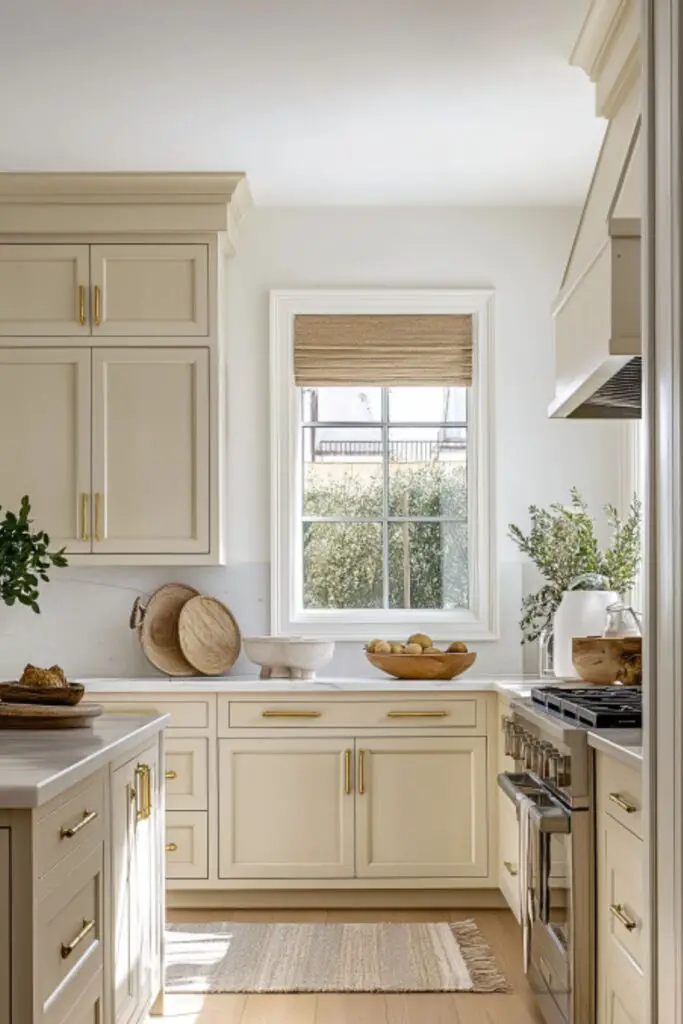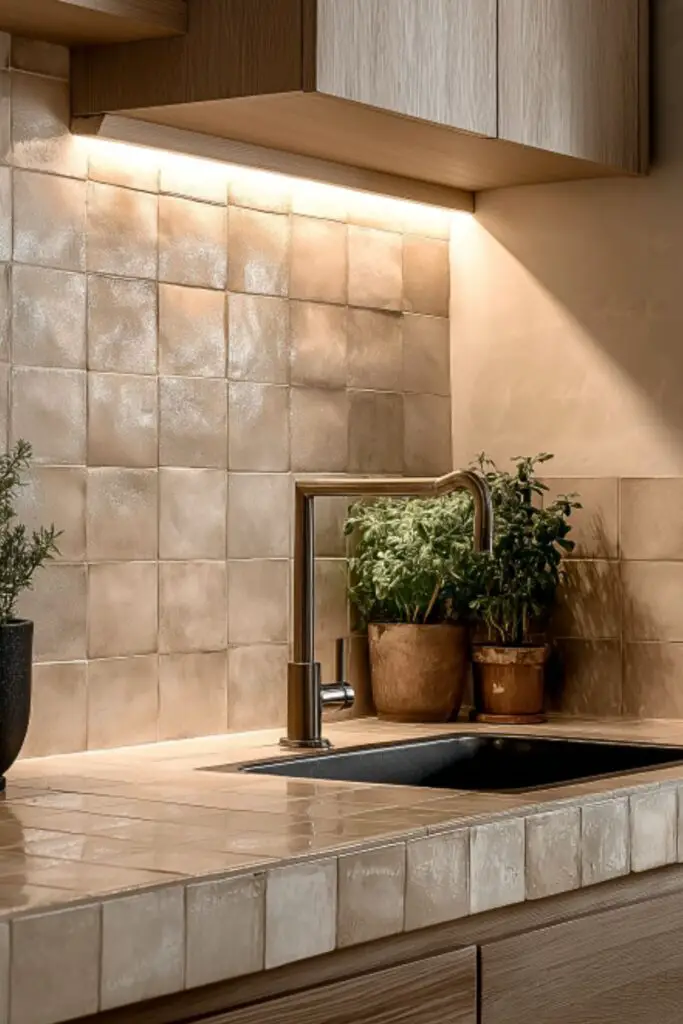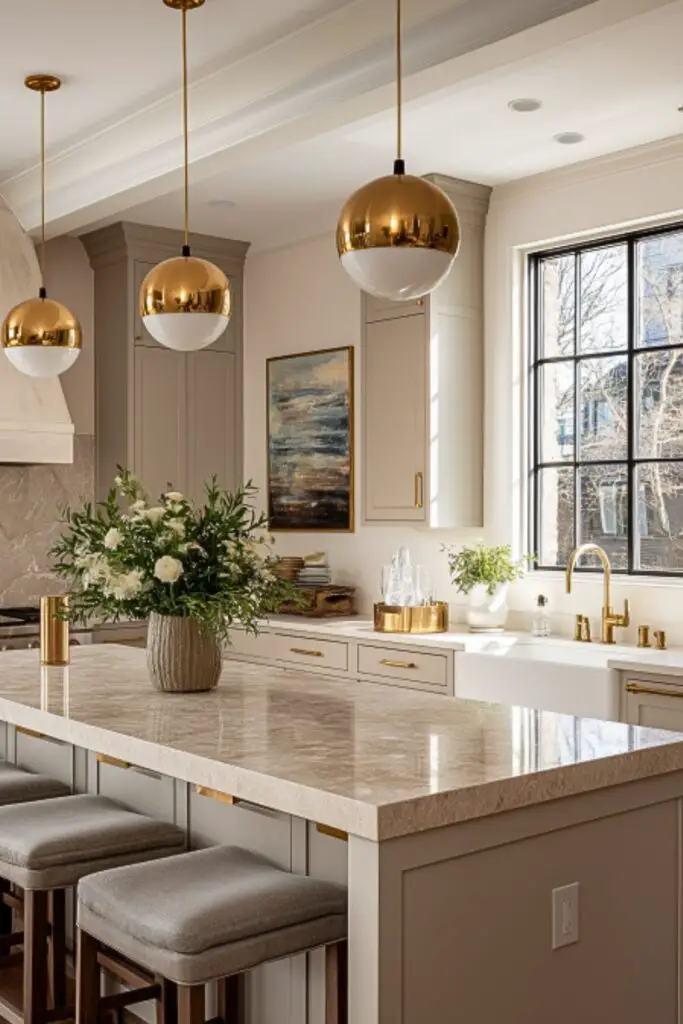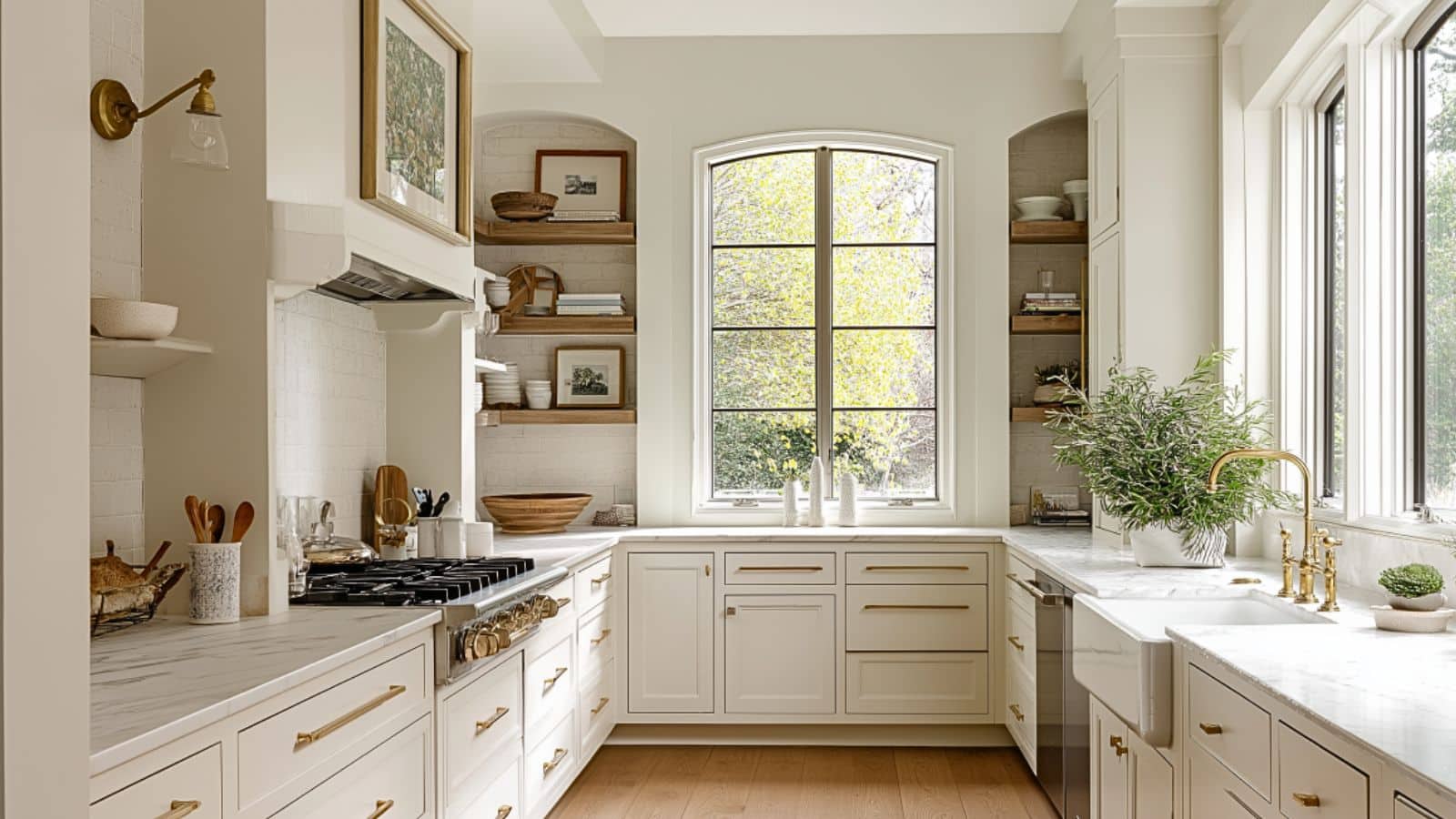10 Warm Neutral Kitchen Ideas You’ll Want to Copy Immediately for Timeless Style
Table of Contents
If the kitchen is the heart of the home, then warm neutral tones are its soul. Gone are the days of stark white cabinets and sterile surfaces. Today’s most coveted kitchens embrace warmth, softness, and a grounded sense of calm. In fact, a recent Houzz survey revealed that over 70% of homeowners now prefer warm neutral palettes in kitchen remodels, citing coziness and timelessness as their top motivations.
But what makes a kitchen “warm neutral”? It’s all about layered earth tones—creams, beiges, tans, mushroom greys, and soft taupes—paired with tactile textures like natural wood, brushed metals, and stone. This look doesn’t scream for attention; instead, it wraps you in understated elegance and invites you to stay awhile.
In this post, we’ll explore 10 beautiful, attainable warm neutral kitchen ideas that feel both refined and livable. Whether you’re planning a renovation or simply looking to refresh your space with color and texture, these ideas offer inspiration for any budget or style preference. From cabinetry finishes to countertops, backsplashes, and decor elements, you’ll find tips and visuals to help you design a kitchen you’ll never want to leave.
Soft Cream Cabinetry That Feels Timeless

When it comes to warm neutral kitchens, soft cream cabinets are a classic choice that never goes out of style. Unlike stark white, cream has a subtle warmth that adds depth without darkening the room.
Why Cream Works So Well
Cream strikes the perfect balance between light and warmth. It reflects light beautifully, making your kitchen feel airy while also grounding the space with a soft undertone. It pairs well with a variety of finishes—brushed brass, matte black, even rustic wood.
Pairing with Natural Materials
Cream cabinets look stunning against white oak floors, natural stone countertops, or a butcher block island. The trick is to mix tones while staying within the warm-neutral family for cohesion.
Keep the Finish Soft
Opt for matte or satin finishes to prevent your cabinets from looking too glossy or artificial. These finishes help enhance the organic feel of the space.
Color & Finish Table: Soft Cream Cabinet Styling
| Design Element | Recommended Choice | Effect Created |
|---|---|---|
| Cabinet Color | Soft cream or ivory | Warm and inviting |
| Hardware Finish | Brushed brass or nickel | Subtle elegance |
| Countertop Pairing | Light granite or quartz | Balanced sophistication |
Natural Wood Accents That Ground the Space

Adding wood elements is one of the best ways to anchor a warm neutral kitchen. Wood brings texture, depth, and a connection to nature that instantly makes the space feel more welcoming.
Choose Light to Mid-Tone Woods
Ash, oak, and walnut are perfect for warm kitchens. Use wood for shelving, vent hoods, stools, or a statement island. Avoid overly red or orange wood tones, which can clash with the calming nature of neutrals.
Blending Wood with Neutrals
When done right, wood pairs effortlessly with warm neutrals like beige, mushroom grey, or greige. It can act as an accent or become the star of the kitchen—especially if you opt for natural wood cabinetry or open shelving.
Let the Grain Show
A clear finish that enhances the wood grain will add dimension and keep things feeling organic. Avoid heavy stains that cover the natural character of the wood.
Where to Use Wood in a Warm Neutral Kitchen
| Wood Element | Suggested Application | Design Impact |
|---|---|---|
| Light oak | Shelves, island, vent hood | Adds softness & warmth |
| Walnut | Open shelving, accent panels | Rich, grounded contrast |
| Butcher block | Island or countertop insert | Rustic, tactile element |
Textured Backsplashes That Add Visual Interest

In a palette as subtle as warm neutrals, texture becomes key. A beautiful, textured backsplash adds dimension and character without overpowering the rest of the kitchen.
Subway Tile, Reimagined
Opt for handmade or zellige-style tiles in off-white, bone, or taupe tones. Their uneven surfaces and glaze variations catch light beautifully and add artisanal charm.
Stone and Terracotta
Travertine, tumbled limestone, or handmade terracotta tiles in beige and cream tones introduce earthy depth. These materials are especially effective in Mediterranean or rustic-inspired kitchens.
Grout Matters
Choosing a warm-toned grout—like soft taupe or oatmeal—can make a big difference in how the backsplash blends with the rest of the space.
Backsplash Material & Finish Guide
| Material Type | Best Color Range | Texture Level |
|---|---|---|
| Handmade subway tile | Bone, cream, light sand | Subtle, artisanal |
| Tumbled travertine | Beige, tan, ivory | High texture |
| Ceramic zellige tile | Warm white, almond | Glossy, handcrafted |
Layered Lighting for Cozy Ambience

Lighting in a warm neutral kitchen should be layered and intentional. It’s not just about functionality—it’s about enhancing mood and drawing out the richness of your color and material choices.
Warm Bulbs Over Cool
Swap out harsh white lights for warm LED bulbs (2700K–3000K range). These flatter the natural tones in your cabinets, counters, and flooring.
Types of Lighting to Include
Layer ambient (ceiling), task (under-cabinet or pendant), and accent lighting (sconces or display lights). This layering creates softness and depth, especially in the evening.
Natural Light Enhancements
Keep windows minimally dressed. A simple Roman shade in linen or a sheer curtain allows natural light to highlight the neutral palette.
Lighting Plan for a Warm Neutral Kitchen
| Lighting Type | Placement | Visual Effect |
|---|---|---|
| Pendant Lights | Above island or peninsula | Central, sculptural |
| Under-Cabinet LEDs | Below uppers | Warm, functional glow |
| Wall Sconces | Near open shelving or art | Cozy accent illumination |
Earthy Countertop Materials That Complement Neutrals
Countertops are one of the largest visual surfaces in a kitchen and play a major role in reinforcing your chosen palette. In warm neutral kitchens, earthy countertops help to bridge color and texture, adding natural elegance to the design.
Natural Stone Countertops
Quartzite, soapstone, or granite with beige, grey, or warm brown veining can elevate a kitchen without feeling flashy. Honed finishes (as opposed to polished) work well in neutral kitchens, offering a softer, more matte appearance.
Quartz That Mimics Natural Patterns
For a more budget-conscious option, quartz countertops designed to imitate marble or travertine are ideal. Look for styles with subtle veining in soft grey or taupe on a creamy background.
Butcher Block for Contrast
If your cabinetry is painted, adding a butcher block countertop section (perhaps on the island) brings a warm, rustic feel that ties in beautifully with the neutral palette.
Pairing Tips
When selecting a countertop, take samples home and view them in natural light. Materials that seem neutral in a showroom can sometimes appear too cool or too yellow depending on your lighting and adjacent surfaces.
Top Countertops for Warm Neutral Kitchens
| Countertop Material | Color Characteristics | Design Benefit |
|---|---|---|
| Honed Quartzite | Cream base, warm veining | Natural elegance |
| Soft-tone Quartz | Taupe or ivory base | Durable, low-maintenance |
| Butcher Block | Light to mid-tone wood | Adds warmth & texture |
Subtle Decor Elements That Pull It All Together
In a space built on subtlety, the decor is where personality shines through. Warm neutral kitchens come to life with curated details that don’t overpower but gently enhance the overall ambiance.
Neutral Textiles for Softness
Linen tea towels, natural fiber rugs, and fabric-covered counter stools bring softness to the hard surfaces. Opt for oatmeal, flax, or soft taupe shades with minimal patterns.
Ceramics and Wood on Display
Hand-thrown pottery, wooden bowls, and stoneware can be both functional and decorative. These tactile elements reinforce the grounded aesthetic and can be rotated with the seasons.
Wall Art and Framed Details
Framed prints in sepia, botanical illustrations, or subtle abstract works can add sophistication without disrupting the palette. Use wood or brass frames to tie in with your finishes.
Greenery Adds Life
Even just a few sprigs of eucalyptus, a pot of thyme on the sill, or a vase of dried grasses can bring natural vitality to the space without feeling like clutter.
Decor Checklist for a Warm Neutral Kitchen
| Element | Suggested Style | Placement Tip |
|---|---|---|
| Neutral Linens | Linen, cotton in soft tones | Hang from hooks or oven bar |
| Ceramic Accents | Unglazed or lightly glazed | Open shelving or counter |
| Organic Greenery | Herbs, grasses, soft greens | Windowsill or center island |
| Wall Art | Minimalist or botanical prints | Above sideboard or shelf |
Greige Walls That Set the Tone
Greige—a blend of grey and beige—is the unsung hero of warm neutral design. It adds dimension and depth to your walls without feeling too cool or too warm.
The Magic of Mid-Tones
Greige works well in spaces with a mix of natural and artificial light. It adapts throughout the day, reflecting a soft glow that enhances the textures and tones around it.
Perfect Backdrop for Cabinets and Decor
This color allows cream cabinets, wood accents, and brass fixtures to stand out while maintaining harmony. It’s especially effective in kitchens with high ceilings or open layouts.
Choosing the Right Shade
Sample multiple greige tones to find one that leans slightly warm (look for names like “Stone”, “Putty”, or “Almond Grey”). Test them on several walls at different times of day.
Greige Color Selection Table
| Brand + Color Name | Undertone | Ideal Pairing |
|---|---|---|
| Benjamin Moore “Edgecomb Gray” | Warm beige-grey | Cream cabinetry |
| Sherwin-Williams “Agreeable Gray” | Balanced greige | Brass + wood accents |
| Farrow & Ball “Skimming Stone” | Pale taupe | Stone or tile backsplash |
Conclusion
Warm neutral kitchens aren’t just a trend—they’re a lifestyle. These spaces invite comfort, connection, and calm with their use of earthy colors, layered textures, and timeless materials. Whether you’re working with a full remodel or subtle styling updates, the beauty lies in the details: the softness of cream cabinetry, the honesty of wood grain, the elegance of layered lighting.
By mixing classic elements with personal touches, you can design a kitchen that feels lived-in yet fresh, curated yet cozy. It’s a style that evolves with time, but never fades out of favor.

